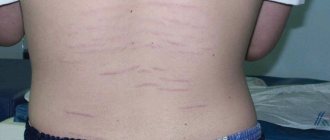Classification of the disease
According to clinical manifestations, childhood anorexia is divided into several types:
- dysthmic - the child cries, is dissatisfied with the process of eating food, is capricious while eating;
- regurgitation - manifested by regurgitation without the presence of other diseases or problems with the gastrointestinal tract during meals or after a heavy lunch;
- active refusal of food - the child may close his mouth, turn away, not swallow, and demonstrate in every possible way his reluctance to eat;
- passive refusal to eat - symptoms include aversion to foods familiar to age.
But it should be remembered that the cause of poor appetite can be not only serious health problems, but also temporary refusal of food during stress, severe overexcitation, illness, or taking certain medications.
Causes
Sometimes the causes of anorexia are very difficult to determine. Scientific research has helped narrow down the likely causes. The first steps to the development of the disease are:
- Unhealthy interest in various methods of losing weight.
- Hatred towards one’s appearance, body, figure.
- Obsession with changing one's appearance through various diets and heavy physical activity.
- A radical change in opinion about health, attractiveness and beauty.
- Imitating the lifestyle of famous actresses, singers, film characters who became famous for their thin physique.
There are a number of reasons why the percentage of development of anorexia in a child increases several times:
- Violation of eating habits. During preschool age, anorexic children are required to follow a strict meal schedule. Food should enter the stomach at the same time every day.
- Eating unwanted foods before the main meal. You can give your child sweets only after he has eaten a hearty meal. It is also important to monitor the amount of confectionery he eats.
- Limited menu. It is preferable to use a two-week nutrition system, which includes products necessary for the growth and development of the child’s body. Otherwise, eating the same food every day will quickly get boring for your child.
One of the most common causes of anorexia in children is force feeding or serving too large portions of food. If you have a one-time lack of appetite, you should not force your teenager to eat right away.
Physical exhaustion can be caused by various psychological factors, which are expressed along with dry mucous membranes, deterioration of the skin, hair and nails.
The most common diseases that contribute to the occurrence of diseases are:
- A negative attitude towards one’s own body, as a result of which a teenager strives for unhealthy weight loss.
- The influence of fashion trends regarding body shape.
- Heredity.
- Frequent stress.
- Having mental health problems.
Symptoms of anorexia in children
Newborns
The symptoms of infantile anorexia are difficult to miss. The baby may protest against eating. At this age, this is manifested by a refusal to put the pacifier in the mouth, suck or swallow. He turns his head away, spits out food, or simply does not swallow.
Another worrying factor is frequent vomiting. Especially after eating a large amount of food. It usually occurs almost immediately after feeding. In addition, children often cry and whine when it comes to eating.
With such manifestations, it is important to exclude the presence of intestinal infections and other health problems. If pathologies are excluded, then without treatment such behavior can become entrenched and lead to severe weight loss and other consequences of the disease.
Toddlers (1-3 years old)
At this age, a child may experience temporary problems with appetite when new foods appear in the diet. Food aversion manifests itself in passive and active ways. In the first case, the symptoms will be the inability to feed adult food - the child’s diet usually does not include meat, vegetables, cereals and other familiar dishes, regardless of the method of preparation.
Active resistance means fighting, pressing lips tightly, spitting out food. The child can also play with food, turn over plates, throw away spoons and forks. If no health problems are found, then treatment for an eating disorder is required.
Preschool age
In children aged 4-7 years, parents may notice the following symptoms:
- direct refusal of food without complaints about health;
- worsening sleep – problems falling asleep, insomnia;
- too much excitability or lethargy;
- isolation in communication with peers - often takes on signs of autism;
- frequent constipation;
- skin itching;
- incontinence.
When communicating with sick children, you should not count on a frank conversation about problems. Despite their young age, children can hide the problem.
It is important to monitor the child’s weight; if it is rapidly decreasing, then this is a 100% factor for consultation with a specialist.
Severe anorexia is much more difficult to deal with, because in addition to psychological problems, you need to literally save lives, as well as minimize negative health consequences.
School age
Diagnosis and treatment of anorexia at the age of 7-10 years becomes much more difficult, because children begin to hide their experiences better. During this period, it is unlikely that the child will decide to throw the plate off the table or start crying loudly.
The manifestation of symptoms begins with frequent avoidance of meals for various reasons. This could be playing sports, studying, or talking with friends. Joint lunches and dinners will become rare, because in the presence of parents it is difficult to throw food in the trash or flush it down the toilet. Girls may become interested in fashion and become interested in famous actresses, ask or search online for information about diets.
You should know that if all of the above symptoms are present, even in the absence of serious weight loss, full treatment is necessary.
To begin treatment, it is necessary to involve a child psychiatrist and other specialists who are familiar with the course of the disease in children. Complicating matters is that parents rarely realize the extent of the problem in time. Therefore, the first visit to a specialist usually occurs two to three years after the onset of symptoms.
The first signs of anorexia nervosa
Parents should be wary if their daughter has:
- conversations about appearance and the need to lose weight become regular (body weight may be within normal limits);
- weight loss;
- nutrition becomes very selective, every calorie eaten is meticulously taken into account;
- some excuses constantly arise aimed at not participating in family lunches and dinners;
- there is constant fatigue, drowsiness, weakness, absent-mindedness, depressed mood - or everything is exactly the opposite: activity increases, mood is elevated;
- menstruation becomes irregular or disappears completely;
- hair begins to fade and fall out;
- the skin becomes dry.
All these signs are a serious reason to immediately seek help from medical specialists.
Diagnosis of the disease in childhood
Diagnosis of childhood nervous diseases is complicated by denial and silence of the reasons for refusing food. Therefore, if the baby can communicate, then treatment begins with a conversation. Parents are also interviewed to look for behavioral problems, changes in weight and appearance.
The process uses special questionnaires to detect eating disorders. You can conduct tests with your child to determine self-esteem and emotional state. Popular methods SMIL, Dembo-Rubinstein and others.
To treat the disorder, you need to rule out other causes of the problem. Especially if symptoms appear in young children. It is almost impossible to establish full contact with them, so the survey is carried out only with parents, test data and the general clinical picture are taken into account.
Also, treatment of childhood anorexia includes general laboratory tests, including blood and urine tests, hormone tests, and checking the condition of the kidneys and liver. To understand the causes of poor appetite, the gastrointestinal tract is examined using instrumental methods.
A child psychiatrist must exclude the early development of schizophrenia or other serious mental disorders, against the background of which anorexia may develop as one of the symptoms. To do this, the specialist checks thinking functions and other features.
Treatment of childhood anorexia
At TsIRPP, you can undergo outpatient and inpatient treatment for childhood anorexia, depending on the patient’s health status at the time of contacting the clinic. We offer:
- an individual approach to solving problems with childhood feeding disorders;
- application of methods of treatment and identification of the causes of the disease that are recognized as effective and safe in the world community;
- a better approach through collaboration with the Linehan Institute, an international academy for eating disorders, where our therapists receive additional training and supervision;
- progressive treatment methods that involve the involvement of relatives;
- drawing up an individual menu taking into account food preferences for each patient;
- treatment services in the intensive care unit if the child is in serious condition;
- participation in family intensives, communication with a psychotherapist via Skype to exclude relapses of childhood anorexia.
Anorexia in adolescents and toddlers is often associated with weight loss, so the first goal of treatment is to address symptoms of malnutrition. At this stage, treatment methods such as frequent fractional and parenteral nutrition and maximum rest in bed are used.
When weight gain is noted, you can begin to address the issue of food perception for children. With the help of a psychologist, psychotherapist or psychiatrist, the fight against the psychological manifestations of anorexia begins. To do this, cognitive behavioral therapy is carried out for up to six months, which allows you to change distorted children's ideas about food and get rid of anger and anxiety.
Family therapy plays an important role in treatment. It is important to find problems in the relationship between parents and child that could provoke the disease.
In newborns (up to one year)
The most difficult thing is to determine anorexia in young children, because they can cry and refuse to eat under the influence of a variety of factors.
Causes
Psychogenic:
- insufficient fat content of breast milk;
- unsuitable mixture;
- incorrect introduction of the first complementary foods;
- congenital pathologies.
Somatogenic:
- bilirubin encephalopathy;
- congenital defects of the oral cavity (prognathism, cleft palate, cleft lip);
- hemolytic disease of the newborn;
- developmental defects of the central nervous system;
- hereditary diseases of amino acid metabolism (hypermethioninemia, maple syrup disease, tyrosinemia);
- prematurity;
- general immaturity of the body;
- weakening of sucking and swallowing reflexes;
- birth or traumatic brain injury.
Symptoms
The signs of anorexia are most clearly expressed in children under 1 year of age - they are easy to notice with the naked eye, because newborns cannot hide their aversion to food.
What parents should pay attention to:
- the baby whines, is capricious, fidgets when it’s time to eat - this is how he expresses his displeasure with this process (this anorexia is called dysthymic);
- the regurgitation reflex is triggered in the absence of underlying digestive diseases (the so-called regurgitant anorexia);
- the newborn does not take the breast, turns away;
- greedily grabs the breast or pacifier, but then spits it out and begins to cry.
At the first sign of an eating disorder, you should immediately inform your pediatrician.
Treatment
Infantile anorexia can be treated successfully only in one case - if its cause is precisely established. If it is another disease, it is identified and treated urgently (or at least the symptoms are eliminated and the condition is alleviated if the pathology is chronic or genetic). If this is related to feeding, you will have to change the eating regimen or the food itself (buy a different formula, for example, or start complementary feeding not with rice porridge, but with buckwheat).
Newborn children suffering from anorexia require vigilant parental attention and urgent measures to eliminate its causes. After all, their main task before the age of 1 year is the growth and formation of internal organs and systems, and with such a diagnosis, full development is impossible.











